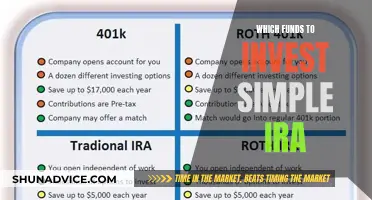
Investing in mutual funds is a great way to build a diversified portfolio without the hassle and high costs of investing in individual stocks and bonds. Mutual funds are baskets of stocks, bonds, or other securities, and they make it easy for investors to diversify their investments, thus lowering their risk.
There are thousands of mutual funds to choose from, and they can be purchased through online brokers or directly from the fund managers. When investing in mutual funds, it is important to consider the fund's investment objectives, fees, and performance. It is also crucial to remember that mutual funds are intended for long-term investors due to their high transaction costs.
1. Set clear investing goals: Determine whether you are investing for the short-term or long-term. This will help you choose the right type of mutual fund and account.
2. Decide on an account type: Choose between a standard brokerage account, a retirement account (such as a 401(k) or IRA), or a taxable brokerage account.
3. Determine your asset allocation: Decide on the right mix of stocks, bonds, and other investments based on your goals, risk tolerance, and investment horizon.
4. Pick an investment strategy: Choose between active and passive funds. Active funds aim to beat the market and usually come with higher fees, while passive funds aim to match market benchmarks and have lower fees.
5. Research mutual fund companies: Look for well-known companies with a good track record and no regulatory issues.
6. Research specific mutual funds: Consider factors such as fees, historical performance, and the fund's investment strategy when selecting a fund.
7. Open an investing account: You can open an account with a brokerage firm, the fund company, or a robo-advisor, depending on your preferences.
8. Buy mutual fund shares: Keep in mind the minimum investment requirements, share classes, and the fact that mutual funds are traded only once per day at the closing price.
9. Be a disciplined long-term investor: Avoid trying to time the market and focus on your long-term investment goals.
10. Don't forget about taxes: Mutual funds have tax implications, so consult with a tax professional to understand the tax consequences of your investments.
| Characteristics | Values |
|---|---|
| Investment Goal | Long-term goals such as retirement or short-term goals such as buying a home or a car |
| Account Type | Standard brokerage account, 401(k), IRA, Roth IRA, etc. |
| Asset Mix | Percentage of portfolio invested in stocks, bonds, and other holdings |
| Investment Strategy | Active (fund manager picks stocks) or passive (matches market benchmarks) |
| Mutual Fund Company | Vanguard, Fidelity, etc. |
| Investment Account | Online brokerage account or investment account with the fund company |
| Investment Minimum | $500-$3,000 |
| Investment Timing | Buy or sell once per day at market close |
| Taxes | Capital gains tax, income tax on dividends |
What You'll Learn

Set clear financial goals and risk tolerance
Setting clear financial goals and understanding your risk tolerance is key to investing in mutual funds. Before you begin investing, you should have a clear idea of what you want to achieve financially, whether that be saving for retirement, a child's education, or a shorter-term goal like buying a home. These goals will influence the type of mutual fund you choose and the level of risk you are willing to take on.
Risk tolerance is the degree of risk that an investor is willing to accept, given the potential for gains or losses in the value of an investment. It is influenced by factors such as age, investment goals, income, and financial obligations. Those with a higher risk tolerance are often willing to invest in stocks, equity funds, and exchange-traded funds (ETFs), while those with a lower risk tolerance tend to favour less volatile investments like bonds, bond funds, and income funds.
When setting your financial goals and assessing your risk tolerance, it's important to consider your investment horizon, or the amount of time you plan to hold your investments. If you have a long-term investment horizon, you may be willing to take on more risk, as you have more time to recover from potential losses. On the other hand, if you are investing for the short-term, you may prefer lower-risk investments to protect your capital.
Your financial goals and risk tolerance will also help you determine the appropriate asset allocation for your portfolio. Asset allocation refers to the mix of investments you hold, such as stocks, bonds, and cash. If you have a high risk tolerance, your asset allocation may be weighted towards stocks, while a more conservative investor might favour a larger allocation of bonds or cash.
It's important to regularly review your financial goals and risk tolerance, especially as your circumstances change over time. This will help ensure that your investment strategy remains aligned with your goals and comfort level.
By setting clear financial goals and understanding your risk tolerance, you can make more informed decisions about investing in mutual funds and build a portfolio that is tailored to your needs and objectives.
Global Funds: Where Are They Invested?
You may want to see also

Understand different types of funds and their benefits
There are four main types of mutual funds: money market funds, bond funds, stock funds, and target-date funds. Each type has its own unique features, risks, and rewards.
Money market funds are considered low-risk investments. They can only invest in certain high-quality, short-term investments issued by US corporations, federal, state, and local governments. Money market funds are often used as a temporary holding place for cash that will be used for future investments or an emergency fund.
Bond funds have higher risks than money market funds as they aim for higher returns. There are many different types of bond funds, so the risks and rewards can vary significantly. Bond funds are considered safer than stocks but offer less potential for growth.
Stock funds invest in corporate stocks and can be further categorized into growth funds and income funds. Growth funds focus on stocks that may not pay regular dividends but offer the potential for above-average financial gains. Income funds, on the other hand, invest in stocks that pay regular dividends.
Target-date funds, also known as lifecycle funds, hold a mix of stocks, bonds, and other investments. The mix gradually shifts over time according to the fund's strategy. These funds are designed for individuals with specific retirement dates in mind, gradually shifting to lower-risk assets as the target date approaches.
In addition to the four main types, there are also index funds, specialty or alternative funds, and balanced or hybrid funds. Index funds aim to replicate the performance of a specific market index, such as the S&P 500. Specialty or alternative funds include hedge funds, managed futures, commodities, and real estate investment trusts. Balanced or hybrid funds are a combination of equity and fixed-income funds with a fixed ratio of investments, such as 60% stocks and 40% bonds.
When choosing a mutual fund, it is important to consider your risk tolerance, investment goals, and time horizon. Each type of fund has its own benefits and risks, so it is essential to understand these before investing.
Invest Wisely: Kotak Select Focus Fund Guide
You may want to see also

Research and compare funds
Researching and comparing mutual funds is a critical step in your investment journey. With thousands of mutual funds to choose from, you need to ensure that your selection aligns with your financial goals and risk tolerance. Here are some key factors to consider when researching and comparing mutual funds:
Performance
Compare the fund's performance against benchmarks, such as indexes or similar funds. Analyse the fund's historical returns over different market cycles, not just during bull markets. Look at the 1-year, 3-year, and 5-year returns, as well as longer periods of 7 or 10 years, to gauge consistency and long-term growth potential.
Risk
Assess the volatility of the fund and its risk-adjusted returns. Evaluate how much risk the fund is taking to generate returns. Consider standard deviation, which measures the spread of returns from the average, and the Sharpe ratio, which indicates the performance against the benchmark.
Investment Strategy
Understand the assets the fund holds and its investment approach. Does it focus on growth, value, or income? How active is the fund manager in decision-making?
Expense Ratio
The expense ratio covers the fund's operating costs, deducted from your returns. A lower expense ratio is generally preferable, as it increases your overall returns.
Fund Type and Category
Different types of funds offer varying levels of risk and return. Equity funds, for instance, invest in stocks, offering higher returns but greater volatility. You can choose between large-cap, mid-cap, or small-cap funds based on your risk tolerance. Debt funds, on the other hand, invest in bonds, providing lower risk and steady income. Hybrid funds combine equities and debt for a balanced approach.
Fund Manager
Evaluate the fund manager's experience, track record, and investment philosophy. A stable and experienced management team indicates better performance over time.
Loads
Some funds charge entry/exit loads or commissions for buying/selling units. No-load funds, which do not have these charges, are generally cheaper.
Portfolio Turnover Ratio (PTR)
The PTR indicates how frequently the fund trades assets within its portfolio. A high PTR may suggest higher transaction costs and taxes, while a lower PTR may result in lower costs, benefiting investors in the long run.
Fund Maturity Periods
Compare the maturity periods of funds to understand how long they have been under management. For short-term financial goals, consider debt funds with maturities that align with your timeline. For long-term wealth accumulation, equity funds with extended maturity periods may be more suitable.
Tax Implications
Different funds attract varying tax implications, such as short-term and long-term capital gains taxes. Consider the tax impact on entry and exit to make informed decisions.
By thoroughly researching and comparing mutual funds using these parameters, you can make more informed investment decisions that align with your financial objectives and risk profile.
Best Mutual Funds: Where to Invest Smartly
You may want to see also

Choose a brokerage account
There are several options for brokerage accounts, each with its own advantages and disadvantages. Here are some factors to consider when choosing a brokerage account for investing in mutual funds:
- Standard Brokerage Account: These accounts can be easily opened through an investment company or bank and offer a wide range of investment options, including stocks, bonds, and mutual funds. When choosing a brokerage firm, consider the fees, investment options, and research tools available. Some popular options include Fidelity and TD Ameritrade.
- Retirement Accounts: If you have a retirement account, such as a 401(k) or an IRA, you may already have access to mutual funds. These accounts offer tax advantages, and mutual funds are commonly included as investment options.
- Online Brokerage Accounts: Online brokerage accounts, such as ETRADE and Betterment, often have lower fees and are easily accessible through digital platforms. They usually charge a transaction fee for each trade and may also have account setup or maintenance fees.
- Investment-cum-Financial Services Companies: Some investment companies, like Vanguard and Fidelity, offer the option to use an in-house account to invest in their own funds as well as those offered by other firms. However, you may incur additional transaction fees or commissions for investing in funds outside of their proprietary offerings.
- Mutual Fund Companies: Investing directly through mutual fund companies can eliminate sales commissions or brokerage fees, as you are buying funds directly from the source. However, your investment options are limited to that company's specific funds. Examples of mutual fund companies include T. Rowe Price, American Century, and Dodge & Cox.
When choosing a brokerage account, it is important to consider the fees, investment options, and research tools available. Additionally, you may want to consider the ease of use and accessibility of the platform, especially if you plan to manage your investments independently. It is also worth noting that some mutual fund companies may charge a fee for investing in off-platform funds, so choosing a brokerage account that aligns with your desired fund provider can be beneficial.
Investment Trust vs Fund: What's the Difference?
You may want to see also

Decide on an investment strategy
Deciding on an investment strategy is a crucial step in investing in mutual funds. Here are some key considerations to help you formulate your investment strategy:
- Goals and Risk Tolerance: Clearly define your investment goals and risk tolerance. Are you investing for long-term capital gains, current income, or a specific purpose such as college expenses or retirement? Can you tolerate dramatic swings in portfolio value, or do you prefer a more conservative approach? Understanding your risk tolerance will help you balance your desire for returns with your ability to handle risk.
- Time Horizon: Determine how long you plan to hold the mutual fund investment. If you anticipate needing the funds in the short term, mutual funds may not be the best option due to sales charges and potential market fluctuations. A longer time horizon, typically five years or more, is ideal for mitigating the impact of short-term charges and allowing your investment to grow.
- Active vs. Passive Management: Decide whether you want an actively or passively managed mutual fund. Actively managed funds have portfolio managers who actively research and make investment decisions, aiming to outperform the market. These funds often come with higher fees. Passively managed funds, also known as index funds, aim to replicate the performance of a benchmark index and usually have lower fees.
- Fund Performance and Management: Evaluate the fund's past performance and the track record of the fund manager. Consider factors such as consistency, volatility, and turnover rates. Review the fund's prospectus and analyse industry and market trends that may impact future performance.
- Fees and Expenses: Mutual funds come with various fees and expenses that can impact your returns. Look out for expense ratios, sales charges or loads, redemption fees, and account maintenance fees. No-load funds and index funds often have lower fees. Compare the fees across different funds to make an informed decision.
- Diversification: Mutual funds offer diversification by pooling money from multiple investors and investing in a variety of assets. Consider investing in different types of mutual funds, such as stock, bond, and balanced funds, to diversify your portfolio and reduce risk. Diversification can help protect your portfolio during market downturns and increase your potential for long-term gains.
- Investment Amount and Frequency: Determine how much you want to invest initially and on an ongoing basis. Mutual funds typically have minimum investment requirements, and some funds may offer lower fees for larger investments. Consider using systematic investment plans (SIPs) to invest regularly and benefit from rupee cost averaging, which can smooth out market fluctuations and improve long-term returns.
- Tax Implications: Understand the tax implications of your mutual fund investments. In some countries, such as India, mutual fund returns may be subject to capital gains tax or income tax. Consider tax-efficient investment strategies, such as investing in tax-saving mutual funds or holding mutual funds in tax-deferred accounts.
Hedge Funds: Risky Business and Unnecessary Investment
You may want to see also
Frequently asked questions
Mutual funds are a pool of money collected from investors that is then invested in securities such as stocks or bonds. Each share in the fund represents a proportional interest in the fund’s portfolio. Mutual funds are intended for long-term investors due to their high transaction costs.
You should consider a fund’s investment objectives and whether they align with your long-term financial plan. Research the fund’s overall approach, investing philosophy, and portfolio managers. Also, consider the fees associated with purchasing shares in the fund.
Mutual funds can be purchased through online brokers or directly from the fund manager. You will need to decide on the amount you wish to invest, and whether you want to buy a certain dollar amount of a fund or a specific number of shares. Most mutual funds have a minimum investment of a few thousand dollars.
Mutual funds are sold in a similar way to how they are bought, through an online broker or the fund manager. You will receive the next available NAV (net asset value per share of the fund) as your price. Mutual funds are not ideal for short-term trading due to early redemption fees.
There are many different types of mutual funds available, including stock funds, bond funds, money market funds, and index funds. Stock funds can focus on companies that pay dividends, growth, specific industries, sectors, or geographies. Bond funds can invest in safe bonds issued by governments or riskier “junk” bonds. Money market funds invest in high-quality short-term debt, while index funds track the performance of an index such as the S&P 500.







